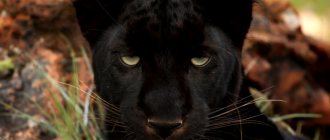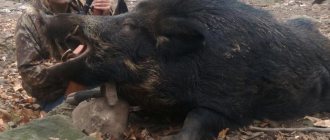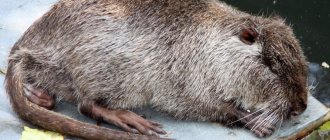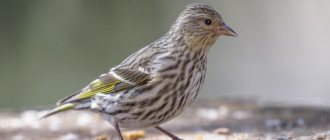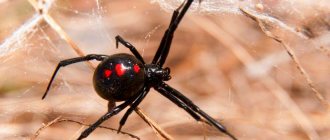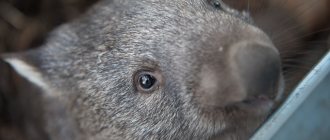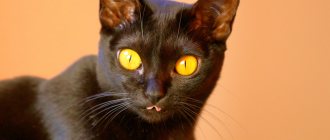Why is the panther black?
The panther's black coloring is caused by special mutations in the animal's genes known as melanism. Such a mutation is very common among predatory felines, for example, in Malaysia, approximately half of all leopards there are black in color as a result of melanism and, in fact, are black panthers.
The black color of these animals often has practical significance (after all, nature is always wise in its actions), so many black panthers live in dense forests, where, with a lack of lighting, dark animals are less noticeable, which makes their life much easier.
Kinds
We can talk about panther species conditionally, since the nature of the animal is based on a genetic mutation of four known species of the cat family: leopard (leopard), jaguar, lion and tiger.
Panther-leopards are superior to lions and tigers in swiftness and agility. The ability to climb trees and rocks, excellent reaction, and fearlessness make them super cats. The ancient Sumerians recognized black panthers as goddesses of fertility and love.
Panther-jaguars are also unique in their ability to survive in different environments. The Indians called them deities of darkness, and the roar of animals was considered a clap of thunder.
Artificial breeding of hybrids, i.e. crossing panthers and other wild cats, led to the appearance of:
- Tigona - a hybrid of a lioness (panther) and a tiger;
- ligra - a hybrid of a tigress and a lion (panther);
- leopona - a hybrid of a lioness and a leopard (panther);
- pumaparda - a hybrid of a puma and a leopard (panther).
Hybrids do not occur in the natural environment due to the different natural habitats of tigers and lions. The birth of kittens of different related species is possible in cramped conditions of zoos and circuses.
Ligers are born much more often than tigons. The hereditary traits of the father predominate in the appearance of the kittens. Today, ligers are the largest cats, reaching 4 meters in height and weighing more than 300 kg. It is almost impossible to get offspring from them.
Tigons appear less frequently. After birth, babies are usually sick and weak. The size of grown individuals is smaller than that of their parents.
As a reminder of the existence of the leopon and pumapard, only stuffed animals, doomed to extinction, remained. Many researchers are convinced that experiments on crossing these predators are futile.
Panther: description, structure, characteristics. What does a panther look like?
The calling card of any panther is its signature black color. Although if you look at the panther more closely, you will notice that its fur is covered with dark spots of different shades, all this creates the appearance of a black color.
Panthers are large predators; the weight of a panther can reach 40-50 kg. The body is oblong and reaches up to two meters in length.
The panther also has four powerful and large paws, with long and sharp claws that retract into the fingers (their structure is approximately the same as that of the kindest representative of felines - the domestic cat).
The panther's head is very large, somewhat elongated, with small ears on the top of the head. The panther's eyes are medium-sized with large pupils. The panther also has sharp teeth and powerful jaws.
The panther has fur all over its body and also has a very long tail, which can sometimes be up to half the length of the animal.
Role in the biosphere
Such a unique animal as the panther enjoys great respect from humans, and this is not surprising, because this predator is not only dazzlingly beautiful.
The panther's intelligence, wisdom, dexterity and desperate fearlessness evoke genuine admiration.
By attacking prey, these predators usually have a positive impact on populations of these species. They catch weakened and sick animals and thereby reduce the number of carriers of the infection and its prevalence.
What does a panther eat?
All panthers are ferocious and dangerous predators, one of the most dangerous among the cat family. If a panther is hungry, it can easily attack any nearby game, including humans.
But most often the panther gets to eat various herbivores: zebras, buffalos, antelopes. Sometimes the panther is not averse to snacking on monkeys. Domestic animals: cows, sheep, horses, also finding themselves unattended in the jungle, have a high chance of becoming food for panthers.
Panthers always go hunting at night; in the dark, thanks to their black color, they become practically invisible, which gives them the opportunity to watch for potential prey without any problems.
Popular message topics
- World Heritage
Many ancient cultural monuments have been able to survive to this day only due to the fact that they have become World Heritage. Time is merciless to many things. And humanity has long been faced with the task of preserving for its own - Swimsuit
Swimsuit is a beautiful and today rare plant that is listed in the Red Book. The beauty of this flower is accompanied by a ball-shaped inflorescence. This flower can most often be any color, most often it is orange. - Mesozoic Era
During this Middle Ages, there was a change and development of the Earth and life on it. During the formation of the Mesozoic era, the formation of the Variscan mountains ended. At the beginning of the Alpine folding, the formation of the Mesozoic era ended.
Panther lifestyle
Panthers, like real representatives of the cat family, are true individualists, preferring to live alone, or in pairs of male + female. Occasionally they can gather in a pride, as lions do, creating a small family of panthers, but this does not happen often.
Panthers are territorial animals; each panther has its own specific territory, so to speak, hunting grounds, where it is not advisable for other panthers to enter.
Panthers are nocturnal, which is greatly facilitated by their black color, thanks to which night hunting is much more preferable for a panther than chasing game during the day.
Lifestyle and habitat
The geographical range of panthers is wide. Numerous populations are found in Asia, South America, and African expanses. If black leopards are more common in the mountains of Ethiopia, then black jaguars live in the American wilds.
In the wild, panthers are attracted to tropical forests and the foothills of mountains. The places where the black panther lives are most often impassable and remote from human settlements. When meeting a person, animals do not show aggression unless they are hungry and do not need self-defense. A dangerous predator has cunning and great strength.
Black panthers are predominantly nocturnal. Their color gives them a significant advantage in hunting. They move silently, smoothly, and their excellent sense of smell allows them to easily detect prey.
During the day, after long walks in the dense forest, panthers sleep for a long time among the branches. They find places to rest in dense thickets at an altitude of 4-5 meters.
The character of animals is characterized by willfulness, perseverance, and determination. Attempts to make the animal domestic and tame inevitably ended in failure. Therefore, it is very rare to see black panthers at circus performances.
They are practically impossible to train. The only attraction with panthers in Europe is run by Maritsa Zapashnaya. The unpredictability of animals is always associated with great risk when working with them.
These are individualists by nature, preferring a single existence or in married couples. The creation of a pride, like that of lions, is a rare exception. Each individual or pair has its own territory, the boundaries of which cannot be violated by relatives.
Panthers are considered perhaps the most bloodthirsty predators among other felines. A hungry animal does not choose a victim, it rushes at every living thing. Panthers have no fear of anyone. The panther can approach a person on its own, unlike other cautious relatives.
Predatory animals are always attractive inhabitants of zoos. Visitors from different countries show a constant interest in wildlife. The mystery of other worlds and the secrets of their inhabitants attract people who make panthers symbols of various cultures. It is no coincidence that the image of the panther Bagheera based on Kipling’s book “Mowgli” became widely known.
An interesting fact was noticed by fans of the English writer. The tale actually shows a male black panther, Bagheer. But during the translation process, the character’s gender was changed, since the word panther is feminine. In addition, the grace, elegance, wisdom, and beauty inherent in the image were usually attributed to heroines.
Possessing colossal patience, panthers can track prey for hours
Panther breeding
Panthers reach sexual maturity by 2-3 years. And since they live in a constantly warm climate, they can reproduce all year round. The male, having found a suitable female, has sexual intercourse with her. Having become pregnant, the female looks for a safe and comfortable place to give birth.
The pregnancy itself in a female panther lasts 3-3.5 months. Usually, a panther gives birth to two or three small kittens (well, not really kittens), like the babies of an ordinary cat, at first they are blind, and only then their eyes appear. At first, mother panther does not leave her babies, feeding them milk, while dad, like a real breadwinner, brings food.
In general, panthers are very caring towards their offspring, and at an older age, the mother panther teaches her cubs how to move correctly, hunt and other intricacies of their animal life. When a panther reaches a year, it already becomes a fully grown animal ready for independent life.
№6
They cannot be called social animals. They lead a lonely lifestyle. The exception is the mating season, when the male begins to look for a female.
After mating, the partners separate and continue to lead a solitary lifestyle.
Males reach sexual maturity at the age of 2 years. Females also mature at 2 years of age.
Albino gorilla
Albinism doesn't just affect humans, it also affects our immediate family from time to time. Other members of the primates may also be born without pigment. Snowflake is the only albino western lowland gorilla recorded in the history of biology. He was born free in Equatorial Guinea in 1964. Snowflake lived most of his 39-year life at the Barcelona Zoo in Spain, where testing revealed his unique mutation was the result of inbreeding in which a female gorilla mated with a male who ended up being her uncle. In the absence of the color black, Snowflake's facial features, unobscured by the pigment and black markings typical of gorillas, gave scientists a glimpse into the human-like appearance of these incredible primates.
Bleached "Beetles"
We tend to think of albino creatures as vertebrates, such as animals, birds, mammals, fish, or even reptiles. However, no creature is too small or primitive to lack pigment. Albino arthropods also grace the white wildlife gallery. This extremely rare albino lobster looks like it has been swimming in chlorine bleach, but its color is completely natural. He lacks a pigment gene, which is why he simply does not have a supply of melanin. The discovery of an albino snail of the species powelliphanta, which is usually brown in color, also surprised scientists. This giant, somewhat creepy species of voracious predator from New Zealand bites other small animals that can't escape it fast enough.
White night creatures
Since ancient times, owls have been considered a symbol of wisdom. Strangely, slightly humanoid nocturnal birds were also seen as harbingers of doom (or even evil spirits, as the superstitious believed). When already aberrant birds inherit albinism, the effect can cause anxiety in even the most resilient of individuals. The albino Great Eagle Owl, also known as the “flying tiger,” is a truly unusual creature of nature. Albinism in bats looks just as unusual and creepy. The sight of one of these insect-hunting flying mammals, swathed in white, is one of the most ghostly and rare in the natural world. Snowy owls and bleached bats are lucky in one respect: they do not suffer the negative effects of albinism-induced photosensitivity.
№9
They are very territorial predators. This is especially true for males. They will be aggressive towards both females (except during the mating season) and males. Typically, males control a significantly larger territory than females.
Also, females often share territory with other females without showing aggression towards them.
The Real Moby Dick
Albino marine mammals are not entirely unknown in literature, thanks to the legend of Moby Dick - the great white whale and the infamous Captain Ahab. However, white whales are not just creatures of legend. The huge, 14-meter albino humpback whale, one of the largest right whales, was first spotted off the coast of Queensland, Australia, in 1991. Many years later, a baby humpback whale, also an albino, was spotted on a popular humpback whale migration route through which about 15,000 whales pass each year. Albino whales may be more sensitive to light at the surface and more susceptible to predation. In an equally strange case, an albino killer whale was captured on film off the coast of Russia in 2012. Given that albino killer whales presumably suffer from reduced immunity, the discovery of this 16-year-old individual truly surprised scientists. All albino killer whales that scientists have found previously were, at most, teenagers.
Classification
The panther genus includes four species of predators:
- Panthera Tigris or tiger is the largest representative of the genus. Its habitat covers several regions of Asia. The population size does not exceed 5 thousand individuals. Science knows about nine subspecies of the tiger, three of which were destroyed in the 20th century.
The weight of a large individual reaches 300 kg or more, a medium-sized animal weighs about 200 kg. The body of the predator is covered with stripes of different lengths, shapes and widths of black or dark brown, the total number of stripes is about 100 pieces. The main color of the coat is dark brown or reddish red.
There are tigers with white, golden and completely black colors.
The Bengal subspecies of tiger is the most dangerous to humans. Interesting facts from past years speak of his special penchant for cannibalism, bloodthirsty disposition, cunning and elusiveness.
- Panthera Leo or lion lives on the African continent (from 16 to 30 thousand individuals), a small population (about 500 individuals) remains in the Girsky Nature Reserve (Gujarat, India). The usual habitat is savannah with dense bushes and tall, coarse grass.
The length of males without a tail is 1.7 - 2.5 meters, females - 1.4 - 1.75 meters. The length of the tail varies from 70 to 105 cm. The height at the withers in females is 107 cm, in males 123 cm. The average weight of males is 190 kg, females weigh from 120 to 180 kg.
African and Asian big cats, panthers, are very similar to each other. Males are 20–30% larger than females and have a thick fluffy mane (length up to 40 cm). The color is uniform, sandy, yellowish-red, light red or brownish-yellow. There are dark brown and white individuals.
They exist alone or in social groups (prides). Prides include up to 9 females, 2–4 adult males, and growing offspring. The main role in hunting is assigned to females. When dividing the prey, the male dominates. Females with cubs do not take part in the hunt; they feed on what other members of the group manage to get.
- Panthera Pardus or leopard is found in Africa and eastern Asia. Lives in tropical, mixed, subtropical forests, savannas, mountains, semi-deserts. The weight and size of the predator vary widely. Body length is from 90 to 180 cm, height at the withers is 45 - 78 cm, weight of males is 60 - 75 kg, females 30 - 65 kg. Tail length from 60 to 110 cm.
The main color of the southern subspecies is yellow-gray, sand, light yellow. In the northern regions, the fur color is yellowish-red, light gray. The pattern consists of ring and solid spots of black or brown color.
Leopards that are black in color are called black panthers.
The animal can hunt prey that is significantly larger than itself; it drags the remaining food up a tree.
- Panthera Onca or jaguar is common in North and South America. It has a muscular, squat body structure and can open its mouth 70 degrees. Average weight 60 - 90 kg, body length 110 - 185 cm, tail - 45 - 75 cm.
The main color palette contains pale yellow, brown or reddish-yellow shades. The spotting is represented by large dark-colored rosettes.
Jaguars settle near water sources. Predator hunting areas often overlap with cougar areas. They give priority in nutrition to ungulates; they love to feast on the internal organs of their prey.
№13
Despite the fact that they prefer to hunt from ambush, they are quite fast predators. Therefore, if the prey notices the cat and tries to run away, it may well catch up with it. But only over short distances. Panthers can briefly reach speeds of up to 58 km/h.
The main disadvantage of these cats is that they are not very hardy. It is for this reason that they prefer to set up ambushes. This makes them more effective hunters.
